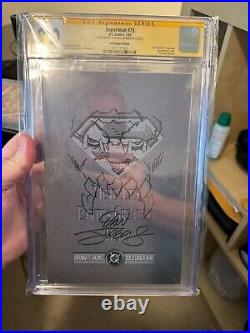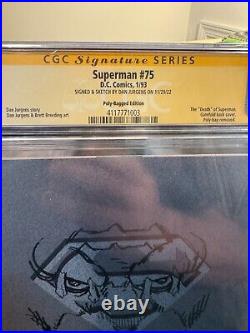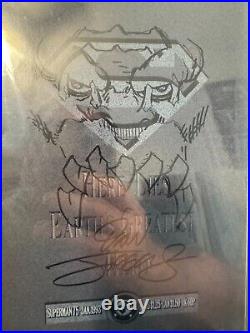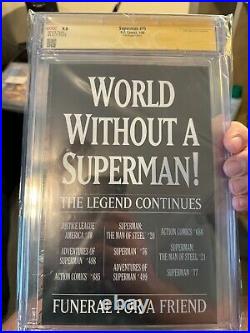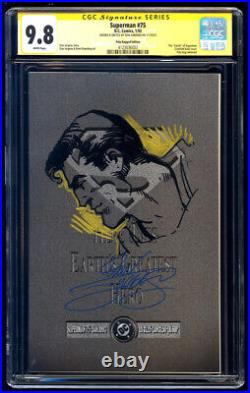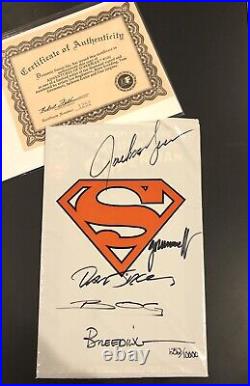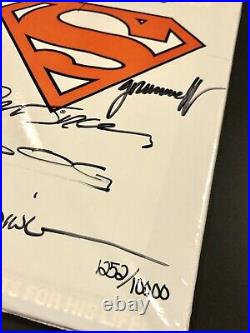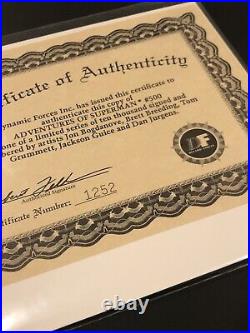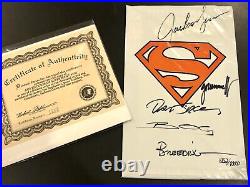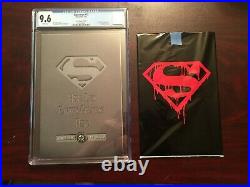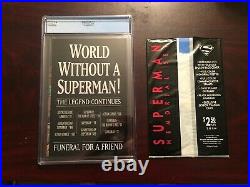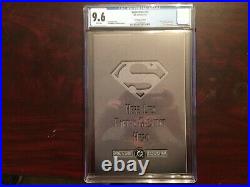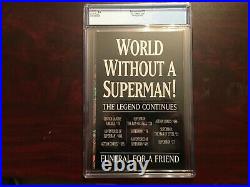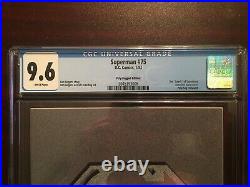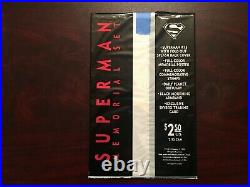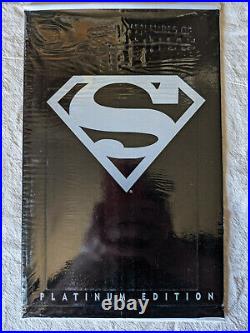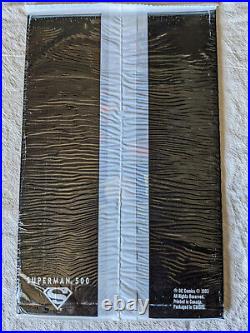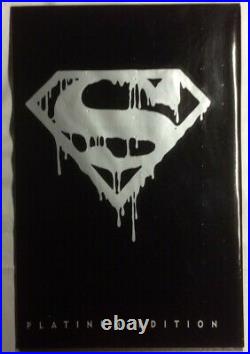



1992 DC COMICS SUPERMAN #75 SEALED Platinum Black Polybag Death Of Superman. This one is the absolute real deal….. Received directly from the hands of the former President of DC! Absolutely mint in my opinion, went from her hands to my hands, then into a protective holder for the past 28 years. Never played with, barely touched, as fresh as a new born baby…. A 28 year old baby! The Death of Superman. For the animated films, see. The Death of Superman (film). Reign of the Supermen (film). ” The Death of Superman ” is a. Story event featured in. The crossover, which originated from editor. Began in December 1992 and lasted until October 1993. It was published in. The Adventures of Superman. Superman: The Man of Steel. Since its initial publication, “The Death of Superman” has been reprinted in various formats and editions. “The Death of Superman”. 2, #75 (Jan 1993) Art by. Over three arcs: Doomsday! ” December 1992 January 1993 ” Funeral for a Friend ” JanuaryJune 1993 ” Reign of the Supermen! (“Funeral for a Friend”). Reign of the Supermen! Green Lantern (Hal Jordan). (All 3 arcs) Dan Jurgens. (Arcs 1 and 2) Jerry Ordway. (Arcs 2 and 3) Karl Kesel. (Arc 2 only) William Messner-Loebs. (Arc 3 only) Gerard Jones. (All 3 arcs) Jon Bogdanove. (Arc 2 only) Dennis Janke. (Arc 3 only) M. (All 3 arcs) Brett Breeding. Doug Hazelwood; Dennis Janke; Denis Rodier (Arcs 1 and 2) Rick Burchett. (Arc 2 only) Mike Machlan. Trevor Scott; Walter Simonson (Arc 3 only) Romeo Tanghal. World Without a Superman. The Return of Superman. The Death and Return of Superman Omnibus. Development began after a planned story, in which. Would be married, was postponed to coincide with a similar storyline in the television series. Lois & Clark: The New Adventures of Superman. While pitching possible replacements, Ordway jokingly suggested that they should kill Superman. As Superman comic sales had declined in recent years, the writing teams felt the character had been taken for granted and decided to temporarily kill him to emphasize his importance. They wanted the crossover to surprise readers and show Superman is not invincible. “The Death of Superman” is divided into three. “, “Funeral for a Friend”, and “Reign of the Supermen! The first arc chronicles Superman’s fight with the monster. And concludes with his apparent death. The second depicts Superman’s fellow superheroes and the rest of the. Mourning his death, ending with his. A number of characters in “The Death of Superman”, such as Doomsday, the. Would recur in later DC publications. When news broke that DC planned to kill Superman, a beloved. “The Death of Superman” received unprecedented coverage from the. Retrospective reviewers are divided on the story, with some finding it ambitious and influential, while others dismiss it as a. The story has been adapted into various forms of media, including two novelizations in 1993 and a. The Death and Return of Superman. Was released in 2007. A second animated adaptation was released as a two-part film. Reign of the Supermen. In 2018 and 2019, respectively. San Diego Comic-Con International. The character debuted in. On April 18, 1938. And the following year became the first superhero to headline his own comic book. Since his debut, Superman has been a. In the United States. In 1985, DC launched the. Crisis on Infinite Earths. Which took place in a variety of comics. Its conclusion resulted in the. That the publisher’s comics, including those related to Superman, take place inbeing. Re-envisioned Superman in his 1986. The Man of Steel. The following year, Byrne. With a new first issue and the original series was renamed. In the reboot, Byrne removed various elements of the Superman. To streamline the character for modern audiences. Which also allowed him to reintroduce them in a new way later on. The relaunch was a major success for DC and. #1 became the bestselling comic book issue of 1986. Byrne also wrote and illustrated. Under Byrne, a new Superman comic was released every week and each series maintained. He spent two years on the Superman comics before leaving in 1988. Dissatisfied with DC’s lack of “conscious support” for him and that the version of Superman licensed for merchandising did not reflect Byrne’s stories. As a result of Byrne’s departure, Superman group editor. Had to assemble new creative teams to replace him. Ordway began to write. The Adventures of Superman , while. Who had recently finished a 12-year stint at rival publisher. Connecting stories also became harder due to the new, more diverse creative teams, whereas Byrne had managed most of them on his own. To control consistency in stories, the teams regularly attended a Superman. Which started in 1988. The summit was a unique method of making the writers work together, focusing their attention to the next year’s worth of stories. These meetings were often dysfunctional, with. Noting they frequently disagreed when discussing story ideas and argued until one person was “left standing”. Carlin recalled that he had to act like a “babysitter” for the 18 creators during summits, and the teams often compromised. When the writing teams were having trouble deciding stories, Ordway would jokingly suggest they kill Superman. Liked the success of the three interconnected Superman comics, so a fourth. While the creative teams believed the quality of the comics increased because there were more people working on them, they experienced a decline in sales. Primarily due to the popularity of violent. A new Superman comic was released every week. The writing teams increased the romantic tension between. (Superman’s civilian identity) and. In an effort to make the comics more appealing. Eventually, they had Kent propose to Lane and reveal he was Superman, and began to plan a storyline about their marriage. According to Carlin, they developed the wedding arc between 1990 and 1991, and planned for it to conclude in. They also considered a Death of… Story, but did not work on it in depth. (pictured in 2012) jokingly suggested that DC should kill Superman. While the Superman comics struggled, DC’s sister company. A television series for. Centered around the relationship between Lane and Kent. One of the ideas that arose during production was the wedding of Lane and Kent. Although the series did not exist in the same. As the comics, Warner Bros. Wanted the Superman brand to remain consistent across all forms of media. As a result, Carlin and DC president. Decided to put the wedding in the comics on hold until. Lois & Clark reached its wedding episode in order that the stories could coincide. With the original storyline set aside in the comics, the teams needed a new event to replace it. The postponement disappointed the writing teams, as they had to put aside a year’s worth of story planning and, according to Simonson, essentially had to come up with something at the last minute. At the 1991 summit, Ordway again made his joke, but no one laughed. Simonson spoke up and said, based on her experience from editing. Comics at Marvel, killing a major character show[s] just how much that character means to his friends, family, enemies, to the whole world! Carlin liked the idea. And in the documentary film. Look, Up in the Sky: The Amazing Story of Superman. (2006), he recalled, the world was taking Superman for granted, so we literally said’let’s show what the world would be like without Superman’. Jurgens formally pitched “The Death of Superman”. And DC let the project move forward, which shocked Ordway. Prior to moving forward, Carlin asked Siegel if he had any concerns with the concept of killing Superman. Siegel felt it was “a good way to shake things up”; the teams felt better knowing he approved. Bogdanove recalled how the story almost began to write itself, from the end backwards. It felt like a story that could make the readers care again, the way we had always cared about Superman. “The Death of Superman” forced DC to cancel a non- canon. Were working on, as it also featured the character’s death. The initial plan called for Superman to be killed in. #75 (January 1993) and resurrected in. #500, as both were milestone issues. Jurgens created the concepts of a monster tearing apart. And an issue dedicated to a single fight sometime before “The Death of Superman”; the teams combined these when developing the story. Carlin had previously rejected the fight idea whenever Jurgens brought it up, feeling it would not be effective without a good story. When deciding which villain should kill Superman, the writers determined that. Relied too much on technology and intellect, and did not want to use one of them or his traditional. Thus, they concluded that a new villain had to take him on physically. They chose to name this villain Doomsday. ” after Carlin wrote the phrase “doomsday for Superman on the whiteboard used for planning, and did not feel giving him an origin was important. The teams wanted Doomsday to have a distinctive look, so they gave all artists a few minutes to create designs and voted for the one they thought was best. Jurgens’ designa massive, muscular humanoid with bones ripping through his skin, inspired by the design style of. The four issues showing Superman’s fight with Doomsday feature a “countdown” of panels: the first has four per page, the second has three, the third has two, and the last simply comprises. Conceived this, as he thought it would increase the suspense and speed of the action. Furthermore, Jurgens wanted to make an issue told through splash pages and the fight seemed like the perfect fit. The story was partly an effort to show the ramifications of a superpowered fight in a city. Because, as Ordway said, it had to have consequences. The final page of issue #75a triple-page spread depicting Lane mourning Supermantook considerable time to create. The writers wanted “The Death of Superman” to surprise readers, as they hoped to emphasize that Superman is not invincible and could be killed by something besides Kryptonite. #75 (January 1993), depicting Lois Lane mourning the dead Superman. Art by Dan Jurgens and Brett Breeding. Chronicling the fallout of Superman’s death did not take long, according to Bogdanove. He thought, as “the real meat of the story”, it allowed them to accomplish their goal: explaining why the character matters. Ordway recalled the most exciting part for him was exploring what the DC Universe would be like without Superman and had fun writing about other characters’ reactions to his death. DC did not intend for Superman’s death to be permanent and the teams kept this a secret; they signed. Preventing them from revealing the character would return. Carlin expected fans to know the death would be temporary. And in 2018 said he still could not believe many did not. However, the teams delayed all Superman comics for three months to create the illusion that he had really been killed because DC’s. Caused Carlin to delay Superman’s resurrection beyond. Furthermore, the teams knew bringing Superman back in that issue would be illogical and held an emergency summit at a hotel in. Where they plotted the final parts of the story. The teams considered bringing Superman back harder than killing him, as they did not want to make fans feel like they had been cheated. They decided to introduce a new version of Superman before bringing back the original, but the writers each had different ideas. Simonson suggested that each writer create their own Superman, which not only solved the problem of what this new character should be like but also let the creative teams have independence after years of forced collaboration. These characters, known as the Supermen, were created using three existing characters Eradicator. And a new one John Henry Irons. According to Bogdanove, they used the Supermen to reinforce “what makes Superman so super”. Stern characterized Eradicator as an Old Testament. Superman who was more alien than human and compared his character to. He wanted the character to be introduced in a way that readers would not be able to tell he was Eradicator until revealed. Conceived Superboy for another series he pitched to editor. Beforehand and characterized him as an. Jurgens chose to reintroduce Henshaw, whom he created a few years earlier, with his Cyborg Superman. He hoped to trick readers into thinking Henshaw was the real Superman before revealing him as a villain. Simonson and Bogdanove based Irons Steel. , an “everyman as Superman”, on the African American folk hero. And the Marvel character. Additional replacements, including “Little-Boy Superman” and “Rock-Creature Superman” were created but never used. Even if their original idea was altered, each writer maintained a sense of individuality for their Superman. #500 was Ordway’s last issue on the title, as he wanted to spend time with his family. His contract was supposed to expire with issue #499 (February 1993) but he desired to end his run on a “historical” note. Ordway also hoped to use a character from. In issue #500 but was unable to do so because of an editorial mandate barring characters from DC’s mature comics line appearing in mainstream books like. Kesel replaced him afterward. Because Jurgens did not want to simply use Superman’s classic design when he was revived, he gave him long hair. The teams also deepened the red and blue of Superman’s costume to signify that things would not be entirely the same for him. Superman briefly wore a black suit after his revival; this design came from a sketch Bogdanove made at a meeting. “The Death of Superman” was first alluded to in Simonson’s. #17 (November 1992); after the issue’s story, a. Panel shows Doomsday’s fist repeatedly punching a wall. The crossover began the following issue, in which Doomsday is unleashed and begins to carve a brutal path of destruction across America. This leads to Superman’s death in. Which DC published on November 18, 1992. There were several variants of issue #75: a standard newsstand edition; a. Poster, stickers, and a. Which cost more than the standard edition. Following the in-comics funeral, all the Superman publications went on hiatus until the release of. #75, collector’s editions of. #500 came in polybags. One version had a translucent white bag with the red. While another came in a black bag with a white logo. Each installment of the story received a second printing. S Abraham Riesman, DC “aggressively” promoted “The Death of Superman” since it had financial incentives to do so, as comic book. Was at its peak. Publishers like DC would designate certain comic book issues as significant, causing. #75, DC issued a. To stores with a cardboard coffin, stickers, and a poster. At the height of the crossover, in May 1993 DC published a special issue. Newstime: The Life and Death of The Man of Steel. It compiled fictional news stories about Superman’s death, providing an. Look at the event. DC published the story in three collected volumes from 1992 to 1993. Was released in time for the 1992. And, according to comics historian Matthew K. Manning, is the bestselling. Reprints of these collections were published in 2003. While a recolored edition of. Was released in 2013. In September 2007, DC released an. It features all the issues from previous collections along with 40 pages dedicated to promotional materials and interviews, for a total of 784 pages. Jurgens also contributed new cover art. A new version of the omnibus edition was published in 2013. While another reissue was released in 2019. Versions of the 2007. Was released in 2015. DC reissued “The Death of Superman” in four “New Edition” volumes in 2016. Superman: The Death of Superman. Superman: Funeral for a Friend. Superman: Reign of the Supermen. Superman: The Return of Superman. DC published another collection. Superman: Doomsday , around the same time; it compiles comics that feature Doomsday’s return. December 1992 January 1993. The Adventures of Superman #497. Superman: The Man of Steel #1819. “Funeral for a Friend”. The Adventures of Superman #498500. Superman: The Man of Steel #2021. The Adventures of Superman #501505. Superman: The Man of Steel #2226. “The Death of Superman” is divided into a trilogy of. The first is known as Doomsday! Which leads to Superman’s death at the hands of Doomsday. The second story arc, “Funeral for a Friend”, which focuses on the immediate aftermath of Superman’s death, began with. The final story arc, Reign of the Supermen! Began with a prologue in. #500 and introduced the Supermen. The title of this arc references Siegel and Shuster’s first Superman story, The Reign of the Superman. It crosses into the larger DC Universe. #46 (October 1993) featuring a tie-in story. Despite the gap between the releases of “Funeral for a Friend” and Reign of the Supermen! , no time passed within the continuity of the comics. “The Death of Superman” concluded in October 1993 with. Superman (Kal-El / Clark Kent) is a superhero with a strong sense of justice, morality, and righteousness. He is the last remaining resident from the planet. Sent him to Earth in a small spaceship before the planet exploded. He has the powers of flight. And super-strength, among others. Jonathan and Martha Kent. Parents who found him after his spaceship crash-landed on their farm. They raised him from his youth with a strong sense of morals and encourage him to use his powers for the betterment of humanity. Lois Lane is a reporter for the. A newspaper based in Metropolis. She is an ambitious woman who is strong and opinionated. As Clark’s fiancée, she knows he is Superman. Is a photographer for the. Olsen is close friends with Superman and designed a watch which emits a high-pitched signal only he can hear. Is a team of superheroes who defend the world from catastrophic threats. Is a being made from protoplasm who comes from an alternate reality in which Superman was killed. She possesses powers similar to his and can also. She attempts to help Superman when Doomsday attacks. Is a businessman with an ends justify the means. He is wealthy, powerful, intelligent, and Superman’s archenemy, viewing him as a threat to humanity. Is a skilled fighter with enhanced strength and reflexes. He is accomplished at gymnastics and deduction, and defends himself with a golden helmet and shield. Doomsday is an ancient Kryptonian monster who, after escaping from his ancient prison, carves a murderous path of destruction across America. He can easily heal from damage and develop resistance to injuries. The name “Doomsday” comes from Booster Gold comparing his rampage to. Is a former employee of. And Superman’s scientific advisor. He has designed and built devices such as a. Is the owner of the Ace o’ Clubs bar in Metropolis. He admires Superman and identifies himself as the hero’s biggest fan. When Doomsday attacks, Bibbowski assists Hamilton and Superman in their efforts to stop him. Four promotional images for Reign of the Supermen! Clockwise from top left: Eradicator (art by Jackson Guice and Denis Rodier), Steel (art by Jon Bogdanove and Dennis Janke), Superboy (art by Tom Grummett and Doug Hazelwood), and the Cyborg Superman (art by Dan Jurgens and Brett Breeding). The “Supermen” are four individuals who claim to be Superman, each representing a different moniker or trait he is associated with taken to the extreme. Represents Superman’s nickname “the Man of Steel”, wears a suit of armor, and wields a hammer. As a boy, he witnessed the death of his parents, while Superman later saved him during a construction site accident. Represents Superman’s nickname “the Man of Tomorrow” and has a half-robotic body. A former astronaut, he holds a grudge against Superman, who saved him after a. Killed everyone in his spaceship crew. Of Superman created by the. He represents Superman’s residence in. While he possesses many of Superman’s abilities, Superboy is brash and impulsive. Represents Superman’s status as “the Last Son of Krypton” and is a visored, energy-powered alien. He has little time for civilian life, instead focusing on delivering justice. Is the ruler of. A space empire where citizens are entertained by. An enemy of Superman, Mongul is stronger than him, intelligent, and can use. Is a member of the. And a former fighter pilot. He gets his powers from a. That allows him to channel. To create objects out of light. Doomsday emerges from an underground bunker and encounters the Justice League International. He easily defeats them, but Superman arrives and the two fight across America. Lois Lane and Jimmy Olsen are sent to cover the battle for television, while Lex Luthor dissuades Supergirl from joining the fight and convinces her that she is needed in Metropolis. Doomsday sees a commercial for a Metropolis wrestling competition and heads for the city. Superman throws Doomsday on the mountain housing Project Cadmus, but fails to stop him from reaching Metropolis. Supergirl rebels against Luthor and goes to Superman’s aid, but a single punch from Doomsday knocks her to the ground. Professor Emil Hamilton and Bibbo Bibbowski fire a laser cannon at Doomsday, but it does not harm him. Doomsday and an exhausted Superman fight and strike each other with so much force that the shockwaves from their punches shatter windows. At the struggle’s culminating moment in front of the. Building, both lay a massive blow upon each other, killing Doomsday and mortally wounding Superman. In the arms of a frantic Lane, Superman succumbs to his wounds and dies. Olsen, Justice League members Ice and Bloodwynd, and Guardian are also present at the end, with Olsen bitterly photographing Superman’s fall. Superman’s death stuns and traumatizes the residents of the DC Universe. His funeral is attended by nearly every superhero, as well as some. Every hero wears a. Featuring Superman’s logo. After the funeral, Project Cadmus steals Superman’s body from his mausoleum to clone him, but Lane and Supergirl recover it. With Superman gone, the. Rises; the costumed heroes of Metropolis, including a team funded by Luthor, rise to fill in as protectors but are insufficient. Jonathan Kent takes Superman’s death the hardest. One night, while reading a newspaper story Lane wrote in Superman’s honor, Jonathan begins to feel responsible for his son’s death and has a. In his wife Martha’s arms. In a coma, Jonathan meets Superman in the afterlife and convinces him to come back, before reawakening. Meanwhile, four men claiming to be SupermanSteel, the Cyborg Superman, Superboy, and Eradicatoremerge, and Lane discovers his grave is empty. Steel and Superboy are disproven as the original Superman. But the Cyborg and Eradicator both seem to recall some of his memories. Hamilton tests the Cyborg and concludes he is the real Superman. In actuality, Eradicator stole Superman’s body and placed it in a regeneration matrix in the. Drawing on his recovering energies for power. A powerless Superman, wearing a black costume, escapes the matrix. The Cyborg helps Mongul destroy. And, in its ruins, they begin to build Engine City in an effort to recreate Mongul’s home planet, Warworld. Superboy asks Steel to help him fight the Cyborg. And Superman and Supergirl join the two. They travel to Engine City. Where the Cyborg launches a missile at Metropolis with the intent of destroying it and building a second Engine City in its place. Superboy manages to stop the missile before it strikes. Devastated, Jordan attacks Engine City and defeats Mongul. Eradicator joins the fight and shields Superman from Kryptonite gas. The gas kills Eradicator but also evolves within him. It passes into Superman, allowing him to regain his powers and defeat the Cyborg. Supergirl uses her powers to reconstruct Superman’s original costume and they return to Metropolis. As DC did not reveal that Superman would be revived at the end of the story, many fans believed “The Death of Superman” had permanently killed Superman, a beloved cultural icon. Thus, it attracted unprecedented coverage from the. Stated news outlets like. And New York’s. Pounced upon the killing of Superman. And it made the front page of. Details of “The Death of Superman” were covered by the media before DC wanted them to and the company’s publicists were not ready to talk about the story when it appeared in. Speculated the death would not last, but nonetheless expressed interest in what a world without Superman would be like. (SNL) parodied “The Death of Superman” in a sketch in the seventh episode of its. The sketch depicts the casts of DC and Marvel attending Superman’s funeral. Tries to enter, but no one knows him even though he claims to have taught Superman how to fly. Named this the best of. The attention caused “The Death of Superman” to become an unforeseen success. Comic book retailers ordered five million copies of. #75 in advance and many people who had never read comics bought the issue hoping it would become an expensive. Some stores had one-per-customer limits on the issue to avoid mobs and lines of customers longer than a. The issue brought in a total of. Making it the bestselling comic book issue of 1992. #75 doubled DC’s market share in November 1992. After the issue was released, Siegel met with Carlin to tell him that “The Death of Superman” impressed him. The success of the event turned Jurgens, who had been an average writer and penciller, into an industry star. The four bestselling issues of 1993 were. Additionally, the first installments of Reign of the Supermen! Were among the top five bestselling comic books of June 1993. Timed the release of. #1 to the release of #75, and. #1 to the release of. #500 to take advantage of the increased customers and boost sales. Both books included cover enhancements to attract customer attention. However, many retailers say. #500 was the beginning of a decline in the comic industry. Retailers and distributors were stuck with unsold copies. And thousands of stores closed. Additionally, those who bought. #75 could only sell first printings for cover price a few months after its release. Some commentators have retrospectively dismissed “The Death of Superman” as little more than a. To give the Superman comics a brief surge in sales. Indeed, each series’ sales immediately declined following Superman’s resurrection. While most fans figured the death was only temporary. Those who did not felt deceived. (2001), the eleventh episode of. Mocks this frustration through a scene in which. And declares “this better not be another fake-out”. Compared the phenomenon to the. Before quickly changing it back after negative publicity, leading to rumors that the company simply did so in an effort to spike sales. Writer Chris Sims believed that most people bought. #75 just to see Superman’s death. While Weldon speculated its sales were propelled by hopes it would become valuable. Green Lantern tie-in story, theorized that the phenomenon may have been due in part to the then-relatively recent poor ending of the. Sims recalled that when he worked in a comic book store in 2009, some customers were shocked that DC was still publishing Superman comics, as they did not read the story’s conclusion. Generally, DC writers have denied “The Death of Superman” was a publicity stunt. Jurgens, for instance, stated he did not anticipate the attention. While Stern believed the sensation was caused only because it was a good story. Levitz said DC had no reason to think the wider public would care because they killed Superman in stories before. Despite these accusations, many view “The Death of Superman” favorably. Sims called the crossover DC’s greatest success of the 1990s and a definitive Superman story. He thought that while killing off an important comics character was not an original idea, “The Death of Superman” was more ambitious and had a greater legacy than other similar events. Also thought it had a major impact, with strong storytelling and a simple, if well-done, central narrative. He said the main story was well planned, especially considering that it could have easily misfired. Brian Salvatore, writing for. Multiversity Comics , believed the story was effective and present[ed] some pretty compelling arguments for why Superman is the greatest superhero of all time, without ever really coming out and saying that. He also praised the characterization, forcing Superman to rely on pure instinct. S Bob Chipman described the event as a “dumb story full of crappy characters embodying almost all of the worst trends of dreadful [1990s] comics, “. And lamented its influence on subsequent Superman films and comics in general. Called the story boring and jumbled, comparing issue #75 to trading cards that intend[ed] to tell a story than an actual comic story. Morris did criticize its subplots as nonsensical and felt Doomsday was terribly designed, disagreeing with Sims that it was a definitive Superman story. Salvatore felt it had missed opportunities and criticized the Justice League’s role in the story, comparing them to punching bags. Both Salvatore and Nevett thought Doomsday came out of nowhere. And Nevett joked he was a “walking plot device” rather than a true villain. Disliked the story because he thought it came out of the blue. There was no build-up, no suspense developed. Superman had no foreboding of some force out there that would conquer him. It all occurred too quickly. “The Death of Superman” had an immediate effect on DC’s comics. DC timed a similar event featuring. “, to happen shortly after “The Death of Superman, followed by the deaths of. Green Lantern’s event, Emerald Twilight. , in which he turned into the villain. Ties to events that occur during “The Death of Superman”. Marvel published the Spider-Man Clone Saga. ” as a response to the media attention “The Death of Superman garnered. It featured Spider-Man having a baby, which Marvel believed would appeal to news outlets. Despite these similar story attempts, Weldon commented that the industry “was in freefall” and death/disabling stunts offered only brief sales spikes. Some characters established during “The Death of Superman” became recurring characters in DC’s comics. Superboy and Steel received. After the story’s conclusion and Steel appears in a. (1997), portrayed by basketball player and Superman fan. Eradicator received a limited series. Superboy remained a fixture of the DC Universe until he was killed in. (20052006), and the Cyborg Superman became a recurring enemy of Superman and Green Lantern. Later comics featuring Doomsday included. (1995), which explores his origin. And Reign of Doomsday. ” (2011), which heavily references “The Death of Superman and features him hunting down the Supermen. In 2011, DC relaunched its entire comics line in an initiative called. Which revamped the DC Universe and erased certain events. The relaunch altered Superman considerably, characterizing him as shorter-tempered and no longer in love with Lois Lane. However, “The Death of Superman” remained intact in the new DC Universe. To coincide with the release of the animated. Film adaptation of the crossover. In 2018, a 12-part. Series began, written by Simonson and illustrated by Cat Staggs, Joel Ojeda, and Laura Braga, among others. The first parts chronicle Superman’s actions hours before Doomsday kills him; later parts follow Jimmy Olsen during the confrontation and the aftermath of Superman’s death. Tales from the Dark Multiverse. Imagines a reality where Superman’s death causes Lois Lane to have a psychological breakdown. Lois goes to the Fortress of Solitude and learns the Eradicator failed to restore Superman. Lois merges with the Eradicator and uses her new abilities to force the world to accept Superman’s ideals. Her murder of criminals leads other heroes to oppose her, including the Cyborg Superman, Steel, and Superboy. Convinced she is correct, Lois fully adopts the identity of the Eradicator. Stern wrote a novelization of “The Death of Superman”. The Death and Life of Superman , in 1993. Additionally, Simonson wrote another adaptation. Superman: Doomsday & Beyond. Around the same time. It features cover art by. Developed a video game based on the story. Which was released in 1994 for the. Super Nintendo Entertainment System. And in 1995 for the. In which the player controls Superman and the Supermen as they attempt to save Metropolis. S Dave Cook considered it the game that “finally [gave] Superman the video game justice he deserves in what is undoubtedly one of his most celebrated stories” and. S Greg Miller called it one of his favorite games and said it was what inspired him to become a video game journalist. In the wake of “The Death of Superman”, Warner Bros. Acquired the rights to produce Superman films, and hired. To write a script for a sequel to. Superman IV: The Quest for Peace. Superman Reborn , borrowed liberally from “The Death of Superman”, including the fight between Superman and Doomsday. Disliked it due to its similar. Later rewrites altered the story considerably and the film ultimately never came to fruition. Another canceled Superman film that would have been directed by. Started as an adaptation of “The Death of Superman”; Warner Bros. Executives believed the story was “the key” to revive the. Superman: Doomsday is loosely based on “The Death of Superman”; to fit within a 75-minute runtime, the story was condensed and greatly altered. For example, the Justice League is not present and most aspects of Reign of the Supermen! The film was a commercial success and started the. DC Universe Animated Original Movies. Line of direct-to-video releases. Series of films contains references to “The Death of Superman”, beginning with the appearance of Superman’s black suit in. Batman v Superman: Dawn of Justice. (2016) draws narrative elements from Doomsday! In the film, Lex Luthor uses forbidden Kryptonian genetic engineering projects to combine. S corpse with his own DNA, creating Doomsday. During their fight, Superman and Doomsday stab each other with a spear and bone, respectively, and both die. Jurgens received a “Special Thanks” credit at the end of the film. (2017), the black suit reappears as an. In a deleted scene. Planned to have Superman wear the suit when he was resurrected in the film, but scrapped the idea in pre-production. Superman will wear the black suit in Snyder’s 2021. Zack Snyder’s Justice League. In 2017, DC announced a two-part animated film adaptation. (2019), to be released as part of the DC Universe Animated Original Movies line. Superman: Doomsday , the new adaptation is more faithful to the comic story. DC’s Tim Beedle considered the films “much less condensed” and said they include many of the fan-favorite moments from the story that were left out of. TV series crossover Crisis on Infinite Earths. , on Earth 75, a scene depicting Lois Lane mourning the dead Superman in. #75 is shown on the news. The item “1992 DC COMICS SUPERMAN #75 SEALED Platinum Black Polybag Death Of Superman” is in sale since Friday, March 5, 2021. This item is in the category “Collectibles\Comics\Modern Age (1992-Now)\Superhero\Superman”. The seller is “lbigby4rf7″ and is located in New York, New York. This item can be shipped to United States.
- Publisher: DC
- Year: 1992
- Grade: 9.0 VF/NM
- Era: Modern Age (1992-Now)
- Genre: Superheroes
- Certification: Uncertified
- Tradition: US Comics
- Character: Superman

